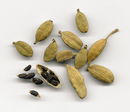Showing Food Cardamom
| General Information | |||||||||||
|---|---|---|---|---|---|---|---|---|---|---|---|
| Name | Cardamom | ||||||||||
| Scientific Name | Elettaria cardamomum | ||||||||||
| Description | Cardamom (or cardamon) refers to several plants of the similar genera Elettaria and Amomum in the ginger family Zingiberaceae. Both genera are native to India, Nepal and Bhutan; they are recognised by their small seed pods, triangular in cross-section and spindle-shaped, with a thin, papery, outer shell and small black seeds. Today, Guatemala is the biggest producer and exporter of cardamom in the world, followed by India. Some other countries such as Sri Lanka have also begun to cultivate it. Elettaria pods are light green while Amomum pods are larger and dark brown. It is the world's third most expensive spice by weight, outstripped in market value only by saffron and vanilla. | ||||||||||
| Primary ID | FOOD00074 | ||||||||||
| Picture |  | ||||||||||
| Classification | |||||||||||
| Group | Herbs and Spices | ||||||||||
| Sub-Group | Spices | ||||||||||
| Taxonomy | |||||||||||
| Superkingdom | Eukaryota | ||||||||||
| Kingdom | Viridiplantae | ||||||||||
| Phylum | Streptophyta | ||||||||||
| Class | Magnoliopsida | ||||||||||
| Order | Zingiberales | ||||||||||
| Family | Zingiberaceae | ||||||||||
| Genus | Elettaria | ||||||||||
| Species | cardamomum | ||||||||||
| Variety | Not Available | ||||||||||
| External Links | |||||||||||
| ITIS ID | 506505 | ||||||||||
| Wikipedia ID | Cardamom | ||||||||||
| Composition | |||||||||||
| Compounds |
Processing... | ||||||||||
| Macronutrients |
Processing... | ||||||||||
| References | |||||||||||
| Content Reference | — Duke, James. 'Dr. Duke's Phytochemical and Ethnobotanical Databases. United States Department of Agriculture.' Agricultural Research Service, Accessed April 27 (2004). — U.S. Department of Agriculture, Agricultural Research Service. 2008. USDA National Nutrient Database for Standard Reference, Release 21. Nutrient Data Laboratory Home Page. — Rothwell JA, Pérez-Jiménez J, Neveu V, Medina-Ramon A, M'Hiri N, Garcia Lobato P, Manach C, Knox K, Eisner R, Wishart D, Scalbert A. (2013) Phenol-Explorer 3.0: a major update of the Phenol-Explorer database to incorporate data on the effects of food processing on polyphenol content. Database, 10.1093/database/bat070. — Shinbo, Y., et al. 'KNApSAcK: a comprehensive species-metabolite relationship database.' Plant Metabolomics. Springer Berlin Heidelberg, 2006. 165-181. | ||||||||||